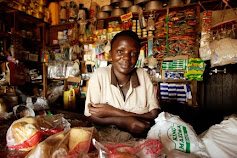
I continue to reflect on the food system issues presented in “Food Inc,” and the fight for food that is both healthy and affordable. It is unfortunate that these two ideals are often placed at opposite ends of the spectrum for our low-income neighbors, and it’s become an even greater issue in our worsening economy. More than ever, it’s time for the church to stand up for these brothers and sisters and fight for food justice.
But an article I recently read by Tom Philpott convicted me about the means to winning that fight. The battle cry for many trying to raise awareness about access to healthy, natural food has been to “vote with our forks” or “vote with our shopping carts.” For me, it was comforting to feel like shopping at the farmer’s market and buying organic produce at Sprouts was making a difference in the fight for a better food system. However, Philpott points out that this cannot be our only strategy if we want to actually work towards a new food paradigm.
He writes, “We can’t simply consume our way to a just national dinner table. To try to do so risks creating two food systems - an artisanal one for people with the resources to care about what’s one on their plates and a low-quality, industrial one for everybody else.
“’Vote with your fork’ neglects the vast role of government and corporate power, decades in the making, in setting up the current system. To really challenge the slop being served by Big Food, we’ll have to vote with our feet as well. We’ll have to take seriously what Wendell Berry has called the ‘agrarian responsibility’ borne by all eaters. That means community - and municipal - level organizing.”
Okay - so what do we do? Grocery shopping is one thing; legislative action is another. Serving a meal to the homeless is a wonderful one-time project, but advocating on their behalf is our lifelong calling. But though it seems daunting, I think we’re up for the challenge, one step at a time.
Read on in Philpott’s article and you will find several suggestions to start picking up your feet and moving towards long-term, deep change in our food system at both local and national levels. Let me share a few ways I’ve discovered to plug in locally:
Fullerton Farmer’s Market. You have two options to buy some great food and enjoy the environment of Fullerton in its hustle and bustle. The Certified Farmer’s Market takes place year-round on Wednesday mornings from 8 a.m. - 2 p.m. in Independence Park of Valencia Drive. From April to the end of October, the Fullerton Market also meets in the plaza across from Epic every Thursday from 4 - 8 p.m.
Hunger Action Los Angeles. Philpott encourages us to participate in a local food council. Orange County does not currently have an official food council, but Hunger Action LA acts as an advocacy organization for food policy issues throughout Southern California. Frequent their website for weekly updates and project opportunities, as well as information for attending their monthly council meetings. http://www.hungeractionla.org/#
California Food Policy Advocates. For more information about food policy actions on the state level, get updated news and resources from CFPA. http://www.cfpa.net/
Center for Food and Justice. Occidental College’s Urban & Environmental Policy Institute promotes a variety of projects and programs working to promote healthy eating and equal access to health education for communities throughout LA and Southern California. http://departments.oxy.edu/uepi/cfj/index.htm
Now it’s your turn! Do some research, and find a program you click with. It’s a reality that we are all busy, so taking on more volunteer work may be more than you can currently handle. You can still sign up to receive news about current food policy issues through any of these websites or the several Philpott recommends. These are just the first steps, but they are important to better understanding how we can directly make an impact for health and food justice in our community.

